The “green” activists’ war on conventional energy is accelerating, and, given that the Trump Administration is fully in favor of developing the nation’s vast storehouses of oil, natural gas, and coal, liberal environmental groups have taken their crusade to the states. This November, four states will vote on anti-conventional-fuel measures, and several more states—including California—are moving laws through the legislatures to dramatically curtail or even outlaw use of conventional fuels. Many of the renewable portfolio standards (RPSs) would also displace nuclear power—one of the most environmentally friendly forms of energy production. Most green activists do not even consider hydropower a renewable source. This shows that the current green movement is in effect a cover for subsidization of companies that generate wind power and solar power.

While natural growth of renewable energy sources is a positive development, mandates are an economically disastrous method that crowds out the market for affordable electricity. Today the United States produces more than 75 percent of its electricity from natural gas, coal, and nuclear power.REF (See Chart 1.) Less than 10 percent comes from solar and wind power. Given the massive federal subsidies of more than $150 billion between 2009 and 2014 to the wind and solar industries,REF that is an amazingly small amount. Chart 2 shows the amount of federal taxpayer subsidy to each form of electricity production per megawatt hour of electricity produced. The subsidies for wind-power and solar-power producers are five to 20 times higher than for traditional energy producers. The most egregious of the federal subsidies is the 30 percent production tax credit for wind power investment and solar power investment. It is hard to find any other industry in America where taxpayers subsidize 30 percent of the cost of production.
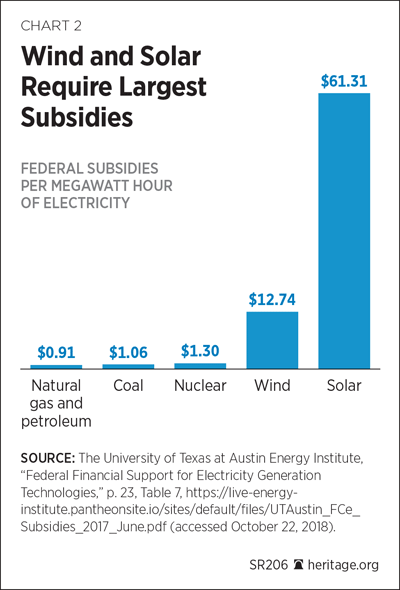
The types of state subsidies that this Special Report addresses are in addition to the federal subsidies. For example, in many areas of the country like California, states are now providing large subsidies for Americans to install solar panels on their rooftops.
But the most unjustified subsidies go to states that require their electricity suppliers to purchase a designated percentage of their electric power from wind and solar producers. These mandates generally range from 10 percent to 50 percent of their residential and commercial electric-power production and are already scheduled to increase in the coming years.REF Map 1 shows where these mandates exist.
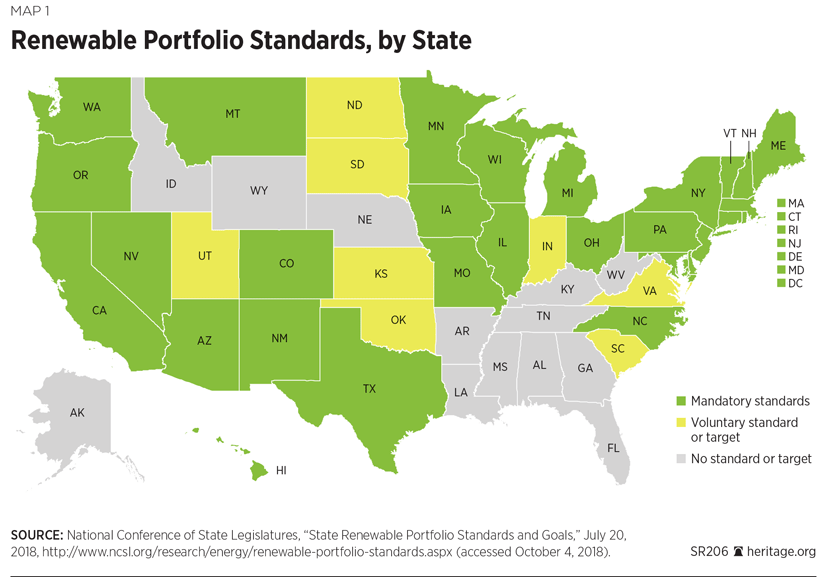
This year, four western states have draconian anti-conventional-fuel initiatives on their November ballots. Several other states have legislative initiatives under consideration as well. The ballot measures have been sponsored by billionaire environmentalists, such has Tom Steyer of California, and extreme environmental groups, such as NextGen Climate ActionREF and the Natural Resources Defense Council (NRDC) Action Fund.REF The states with such initiatives are:
Arizona. Proposition 127 on Arizona’s statewide ballot this November will ask voters if the state constitution should be amended to require that utilities and electric cooperatives generate at least 50 percent of their annual sales of electricity from renewable energy sources by 2030—up from 15 percent today.REF Existing utilities would need to be retrofitted to deliver greater quantities of renewable energy (primarily wind and solar power). The initiative also includes a requirement that at least 10 percent of utilities’ renewable generation come from rooftop solar panels, the least-efficient and most-expensive form of solar power.
California. The Golden State already imposes one of the highest RPSs in the nation, at 25 percent, but now the state is raising that requirement to 60 percent by 2030 and considering 100 percent by 2045.REF
Colorado. Proposition 112 would mandate that new oil and gas development projects that include fracking be a minimum distance of 2,500 feet from occupied buildings and other areas designated as vulnerable.REF
Nevada. Question 6 requires electric utilities to acquire 50 percent of their power from renewable sources by 2030.REF It is similar to the Arizona initiative.
New Jersey. Governor Phil Murphy signed a law earlier this year that requires 50 percent renewable energy by 2030. The governor and legislature are now considering a requirement that moves to 100 percent renewable energy by 2050.REF
New York. Governor Andrew Cuomo is promoting a legislative initiative that would commit $1.4 billion to 26 renewable energy projects, including 22 solar farms, three wind farms, and one hydroelectric project.REF
Washington. Initiative 1631 would impose a fee on carbon emissions from power plants, refineries, and other specified emitters.REF
Supporters of these “green energy” initiatives claim that the results of the move to renewable energy will be lower costs, more jobs, cleaner air, and a healthier future. Alas, the financial reality is vastly different from the rhetoric of the supporters. In nearly all cases in which renewable mandates have been imposed, electric bills have risen far faster than in states without renewable energy mandates. States with renewable mandate goals of 50 percent or more (as would be required by Proposition 127 in Arizona) also have residential electricity rates of about 40 percent to 50 percent higher than states without such requirements. And in states with the highest mandates—such as California—families and individuals sometimes pay nearly double the rate of that in states without mandates. (See Chart 3.)

Of course, some states have higher electricity costs than others for a variety of reasons, including weather, topography, natural resources, and demand, but RPSs are clearly a factor. For example, although Washington passed an RPS in 2006, its great amount of hydroelectric power yields very affordable rates.
Another major finding of this Special Report is that lower-income families would be most adversely affected by stricter green-energy requirements. This is because poorer households typically pay roughly seven times more as a share of their income in energy costs than do wealthier families. Middle-class families pay at least twice as high a share of their income in energy bills than do the rich.
For this reason, the “clean energy” initiative is best thought of as a regressive tax, imposed on those who can least afford it. This “tax” could cost middle-income and lower-income Arizona households over $1,000 more per year in utility prices.
Arizona and Nevada are hardly the first jurisdictions to consider an RPS, so it is useful to see what has happened in other states. Today, some 29 states comprising two-thirds of America’s population have an RPS, and the rest do not. As of 2018 these mandates range from about 25 percent or more in four states (California, New York, Iowa, and Vermont) to as low as 10 percent or less in others. One purpose of this Special Report is to compare rates in states with and without RPSs in order to determine whether there is a difference in rates.
We also examine whether rates have risen, fallen, or remained the same after states have adopted RPSs.
The U.S. Energy Information Administration’s (EIA’s) latest residential data, from June 2018,REF shows that of the 10 states with the highest residential electricity rates in the country, nine have RPSs. Of the 10 states with the lowest electric power rates, seven have no RPSs. The highest on average are double the figures of the lowest rates.REF
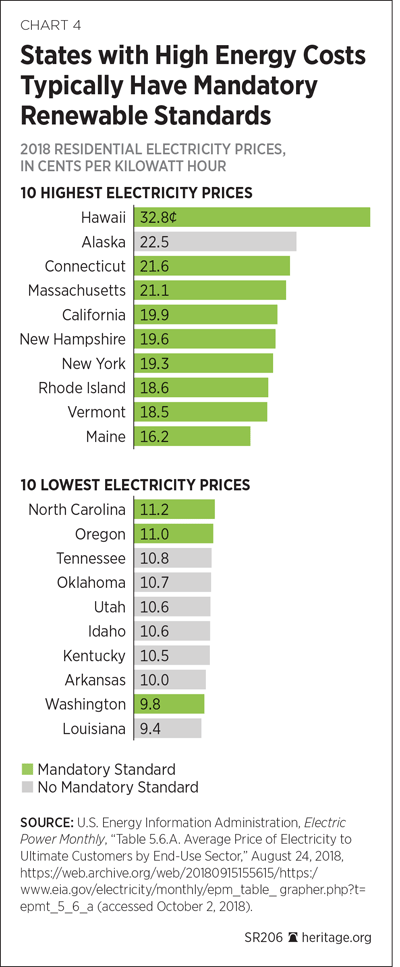
Comparing the states with the most stringent RPSs (25 percent or more) with the states with low RSPs (10 percent or less), and then with states with no RPS, reveals the same pattern. States with high RPSs have rates that are about 27 percent per kilowatt hour more expensive than states with low RPSs, and about 50 percent higher than states with no RPS. (See Chart 5.)
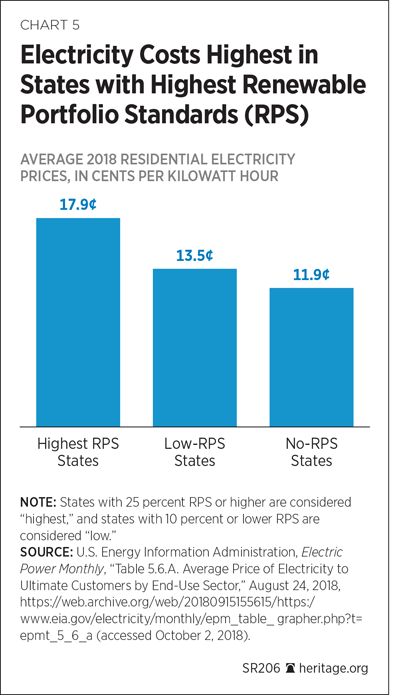
This could easily mean a difference of about $500 to $1,000 a year in higher utility bills for a middle-class family in a typical state. It could mean tens of thousands of dollars of higher costs for a business, depending on energy usage. For manufacturers, it could mean $100,000 or more of extra costs.
The difference in prices in states with low RPSs and states without RPSs is fairly small. This suggests that modest and attainable RPSs do not impose a substantial burden on homeowners and businesses, because most utilities already purchase about 10 percent to 20 percent of their power from renewable energy producers.REF
While there are many reasons why some states have higher utility rates than others, the evidence clearly shows that states aiming to keep utility costs low would be wise to avoid a stringent RPS.
One might argue that states with an RPS already had high energy costs to begin with, and therefore it is important to not just compare prices across states, but also to include what happens to state utility prices before and after they adopt an RPS. Do prices rise faster in these states than in states that avoid an RPS? The answer is yes.
A 2012 landmark study by the Manhattan Institute compared what happened in states with high coal use when they were forced to adopt an RPS and shift the energy-source composition to wind and solar. The study discovered that in 2001, the average price of residential electricity in the coal-dependent RPS states was 10.9 percent higher than the average price in the coal-dependent non-RPS states.REF By 2010, that differential had more than tripled to 37.6 percent. In other words, over the course of a decade, the RPS states saw a tripling in the price differential with the non-RPS states. In almost all the states that adopted an RPS, the environmental groups had promised that prices would not rise due to the mandates, because of technology improvements in solar and wind. Those are very similar to the claims being made by the NRDC in Arizona today.REF
The California and New York Experiences
California, which moved to a 50 percent renewable energy goal in 2015, now charges residents almost 20 cents per kilowatt hour. That is the fifth-highest rate in the country (only Hawaii, Alaska, Connecticut, and Massachusetts pay more). Slightly behind California is New York, where consumers pay 19.3 cents per kilowatt hour, thanks in part to a 30 percent RPS. By contrast, Arizonans currently pay just a little more than the national average, which is 13.1 cents per kilowatt hour, according to the EIA. This means if Arizona’s energy bills rose to the level of California, Arizonans and Nevadans would pay almost 30 percent more each month in utility bills. (See Chart 6.)
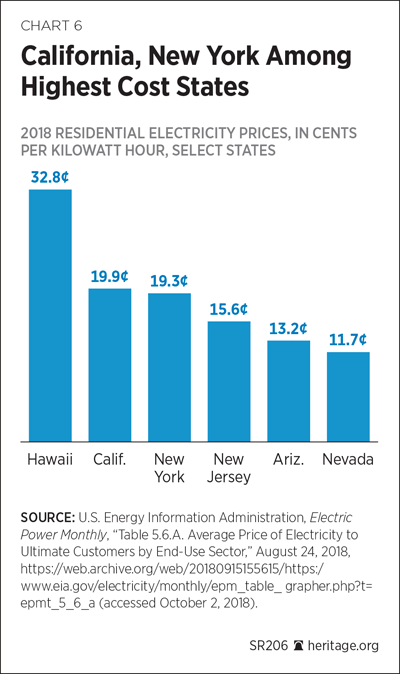
Furthermore, since 2011, the cost of energy is California has risen at five times the rate of increases in the rest of the country, according to the Berkeley-based think tank Environmental Progress.REF The cause of the increase? “[S]ince the power crisis of the early 2000’s settled down, the dominant policy driver in the electricity sector has unquestionably been a focus on developing renewable sources of electricity generation,” says James Bushnell, an economics professor at the University of California at Davis.REF One study found that in 2016, California’s rate for commercial customers was about 45 percent more than the national average, and the state’s industrial customers paid nearly 73 percent more than the national average.REF
Florida is at the other end of the energy spectrum. It does not have a clean energy mandate, and it uses natural gas, solar energy, clean coal, and nuclear power. Its utility costs have fallen by 3 percent since 2011. Does Arizona want to pay rates more like those of affordable Florida or costly California?
The evidence from other states throughout the country is clear: Renewable energy mandates drive up electricity costs.
Why Does an RPS Drive Up Prices?
One major reason for the higher costs of RPS states is that the mandate often precludes utilities from buying the lowest-cost energy source. For example, even in circumstances where natural gas or coal prices are very low, if a utility has not met its RPS requirement, it will have to purchase more expensive wind or solar power to comply with the mandate.
The other lesson from the failed experiment with RPSs is that politicians, regulators, and activists cannot know what the most affordable energy supply will be two, or five, or certainly not 10 years down the line. A recent case in point has been the dramatic and entirely unexpected reduction in natural gas prices from more than $10 per million cubic feet to about $3 today. This 70 percent reduction in domestic natural gas prices has made the fuel much more affordable than virtually any other source of electric power, and more cost efficient than wind and solar power in many states. Today wind and solar power require federal taxpayer subsidies that range from five times to 60 times as high as any subsidy provided for natural gas or coal. (Reminder: Federal tax law provides a 30 percent tax credit for all energy produced from wind and solar, a cost borne by taxpayers. Almost no other industry in America receives that advantage.)
Moreover, energy experts and regulators largely failed to anticipate the reduction in natural gas prices due to drilling breakthroughs in 2006 that gave producers massive access to shale gas from North Dakota to West Virginia. The era of $3 natural gas significantly altered the energy industry. States without RPSs were able to react instantly to the windfall benefit of lower rates passed on to their customers. One lesson here is that locking a state into one form of energy production over another can have unintended harmful consequences, given the dynamic nature of the energy sector.
Who Bears the Cost of Higher Energy Prices?
Some proponents of Arizona’s Proposition 127 and Nevada’s Question 6 argue plausibly that higher energy costs are worthwhile in exchange for clean power and cleaner air. Not only are the claims of environmental benefits unsubstantiated, but these green energy advocates typically ignore that higher energy costs are deeply regressive—hitting those with low incomes the hardest, and eating up around seven times more of their income than the income of wealthier families, according to the Census Bureau. (See Chart 7.) So a millionaire or a billionaire will pay a tiny fraction of about 1 percent of their income in energy costs, while a poor household could pay well over 10 percent, with no measurable effect on air quality or climate.REF
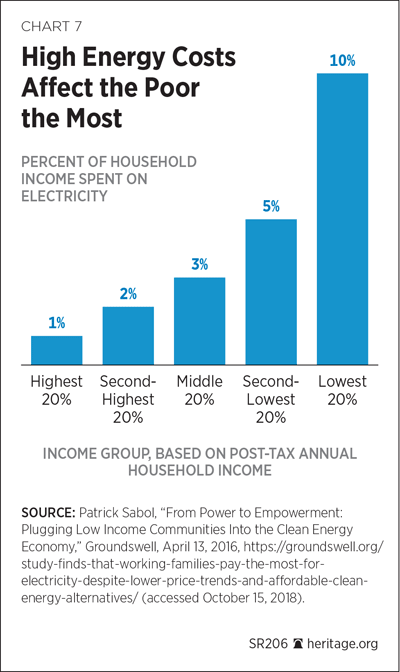
It is a painful irony that the most vocal advocates for RPSs, and those who are primary funders of measures like the one in Arizona, are often billionaire plutocrats, such as Tom Steyer (who does not even live in Arizona). Energy mandates are a 21st-century reversal of Robin Hood: Stealing from the poor to subsidize the rich.
Renewable Portfolio Standards Will Not Improve the Environment
One of the critical flaws of renewable energy requirements is that they almost all squeeze out two of the most dominant and cleanest forms of energy used across the country: natural gas and nuclear power. Green energy requirements include wind and solar power primarily, and exclude nuclear energy and natural gas. But from an environmental and clean air standpoint, and for the purposes of reducing greenhouse gases that may be linked to climate change, this distinction makes no sense. It appears simply to be a multibillion-dollar corporate welfare giveaway to the solar and wind industries at the expense of ratepayers.
Nearly every study has shown that America’s increased reliance on natural gas as a domestic utility is the main reason why American has reduced its carbon and greenhouse gas emissions more than virtually any other industrialized nation over the past decade—and far more than major global polluters China and India. Natural gas now supplies well over one-third of U.S. electric power, and that percentage is expected to rise steadily over the next decade.REF Natural gas has the advantage of being affordable—the price has fallen from $10 to $3 in a decade thanks to the shale gas production explosion—it is reliable, it is produced in America, and it is clean burning. There is no logical environmental reason for utilities to use less natural gas. If energy providers do use less, homeowners and businesses may pay more for energy than their counterparts elsewhere—unless the cost of solar power production and storage falls dramatically.
Even safer is nuclear power, which emits virtually zero emissions into the atmosphere. It is by far the most effective way of reducing greenhouse gas emissions.REF It is by far the most affordable way to reduce ozone, lead, carbon monoxide, and smog. The Palo Verde nuclear plant in Arizona helps improve the atmosphere while meeting the energy needs of 4 million Americans. Detractors of nuclear energy should understand that nuclear waste is not an environmental issue, but the government’s failure to meet its legal obligations to collection and disposal creates a major barrier to nuclear energy’s long-term viability.REF
Even the technology used to burn coal in Arizona, Nevada, and other states is much cleaner today than it was 10, 20, or 30 years ago. All of this is evidenced by the dramatic improvement in air quality nationally over the past 35 years.REF Only a small percentage of this progress is due to renewable energy, because over most of this period, wind and solar power have been fairly inconsequential sources of U.S. energy production.
Since 1980, total emissions of the six principle air pollutants have fallen by 67 percent. (See Chart 8.) To put that in perspective: This decline occurred amid a dramatic expansion of the U.S. economy. Gross domestic product increased by 165 percent, vehicle miles traveled increased by 110 percent, the U.S. population grew by 44 percent, and energy consumption increased by 25 percent.REF The net effect has been a remarkable improvement in air quality throughout the United States.
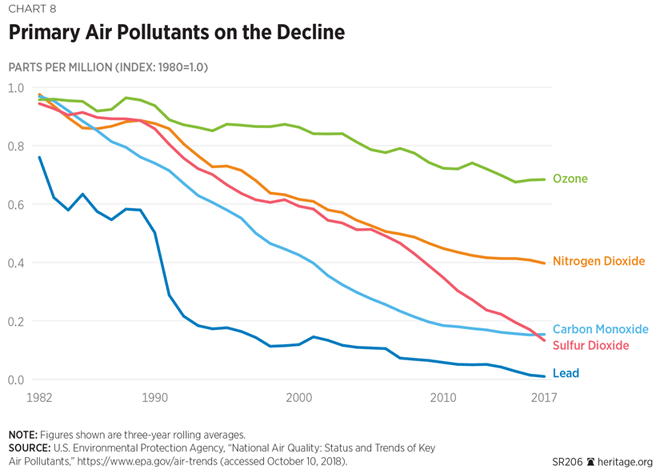
This is why higher RPSs will have almost no impact on air quality or greenhouse gas emissions in states proposing such legislation. Chart 9 shows that Arizona already gets 51 percent of its energy from “clean sources”—nuclear power and natural gas.REF
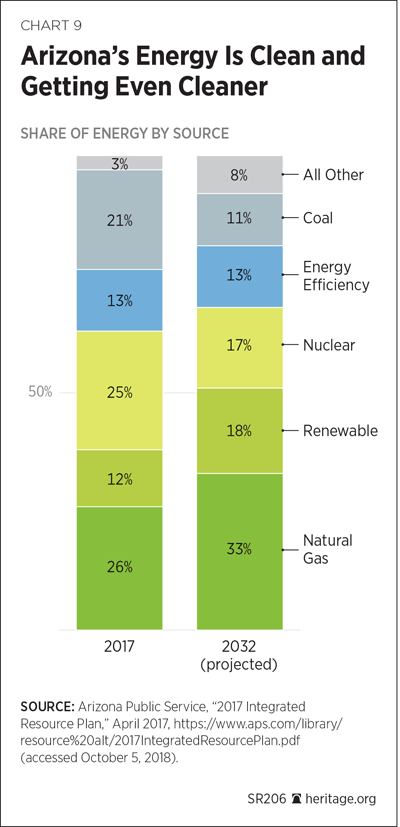
Moreover, a clean energy future is already in the cards for almost all states without mandates. The EIA estimates that by 2030, 50.3 percent of America’s energy consumption will come from natural gas, nuclear power, hydropower, and other renewable sources.REF This means that more than half of green energy production will take place without draconian and uneconomical requirements by state governments. The major effect of green energy mandates is to require utilities to use less nuclear power and natural gas and more wind and solar power—even though nuclear power and natural gas are expected to continue to be much cheaper to produce. If that dynamic shifts and solar power becomes more affordable, as proponents of the state initiatives are betting will happen, RPSs are unnecessary because the trend toward solar power in the composition of energy will happen through market competitive forces.
Renewable energy advocates tend to overlook the many factors contributing to air quality. A major factor is cars, which are not affected by renewable energy mandates. Another is livestock farming, which is also not affected. Other factors are often beyond the reach of government regulation and beyond a state’s borders. Air quality can, for example, be influenced by naturally occurring phenomena, such as wildfires. It can also be influenced by emissions from other states or even another country, such as Mexico.
Renewable Portfolio Standards Are All Pain, No Gain
This study warns that energy costs in Arizona, California, Nevada, New Jersey, New York, and other states considering higher RPSs could rise by as much as 40 percent to 50 percent by 2030. This has been the almost universal experience of other states. If green energy from the wind and the sun becomes price competitive (as green groups predict will happen with almost 100 percent certainty), markets will move toward buying far more of it. The free market should be used to keep energy prices low, not government. Even if groups like the NRDC are correct that solar prices will fall substantially over the next decade, this would not make the case for passage of high RPSs. In this case, the energy market will move states toward greater reliance on solar energy—and that would certainly be a positive development.
Green energy mandates are a big gamble—of a state’s entire economy—on the future of wind and solar power. If that bet is wrong—as it has been in most states—the consequences for families and businesses could be disastrous, and it will be the poorest Americans who suffer most.
—Stephen Moore is Distinguished Visiting Fellow, and Andrew Vanderplas is Special Assistant and Research Associate in the Project for Economic Growth, of the Institute for Economic Freedom, at The Heritage Foundation.

